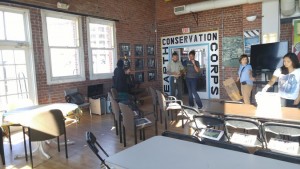Citizen Science, Environmental Outreach and Water Quality
By Ibrahim Goodwin
Spring is here, the eaglets in the Anacostia River Basin have hatched and so has another opportunity to make a visible difference in our nation’s watersheds.
 Here in DC’s Anacostia watershed, EPA and the Earth Conservation Corps (ECC) are working together as part of the Anacostia Watershed Outreach and Education Initiative. We’re encouraging citizen science field research with ECC members, students and others. We test for water quality parameters like pH, temperature, dissolved oxygen, turbidity, phosphates, nitrates, salinity, and we’re analyzing samples for aquatic macroinvertebrates (water bugs you can see with the naked eye that are important indicators of water quality).
Here in DC’s Anacostia watershed, EPA and the Earth Conservation Corps (ECC) are working together as part of the Anacostia Watershed Outreach and Education Initiative. We’re encouraging citizen science field research with ECC members, students and others. We test for water quality parameters like pH, temperature, dissolved oxygen, turbidity, phosphates, nitrates, salinity, and we’re analyzing samples for aquatic macroinvertebrates (water bugs you can see with the naked eye that are important indicators of water quality).
At the ECC Pumphouse, EPA is helping to make this urban river a classroom. We recently sponsored “Protecting the Anacostia Watershed – A Workshop on Water Quality Standards.” This activity, held on World Water Monitoring Day, also highlighted the Urban Waters Federal Partnership between EPA, ECC, the U.S. Forest Service, National Geographic and DC Water.
river a classroom. We recently sponsored “Protecting the Anacostia Watershed – A Workshop on Water Quality Standards.” This activity, held on World Water Monitoring Day, also highlighted the Urban Waters Federal Partnership between EPA, ECC, the U.S. Forest Service, National Geographic and DC Water.
The interactive water quality workshop and hands-on water sample collection and analysis program offered over 75 students and citizen scientists an intimate look at how everyday pollution affects our local environment. We also discussed simple solutions to curbing complicated pollution problems. The young citizen scientists from St. Augustine Catholic School in Northwest Washington, DC were captivated by activities like the owl encounter, water quality monitoring, macroinvertebrate identification and National Geographic’s FieldScope GIS and data system.
This workshop can be modified to fit any watershed. Our workshop, ‘’Watersheds and Water Monitoring,” is being held on the largest free-flowing river in the contiguous United States. The river is home to all sorts of wildlife, including over 300 species of birds.
 Working with young citizen scientists in a hands-on setting reminds me how important my daily work at the EPA is in protecting the environment and educating the next generation of environmental stewards.
Working with young citizen scientists in a hands-on setting reminds me how important my daily work at the EPA is in protecting the environment and educating the next generation of environmental stewards.
About the Author: Bryan “Ibrahim” Goodwin has worked in the Office of Water as an Environmental Scientist since 1987. Mr. Goodwin has helped to train thousands of environmental professionals in the Water Quality Standards Academy and is currently working on initiatives to engage citizen scientists. He received a B. S. in Geology from Howard University and is an avid gardener.
